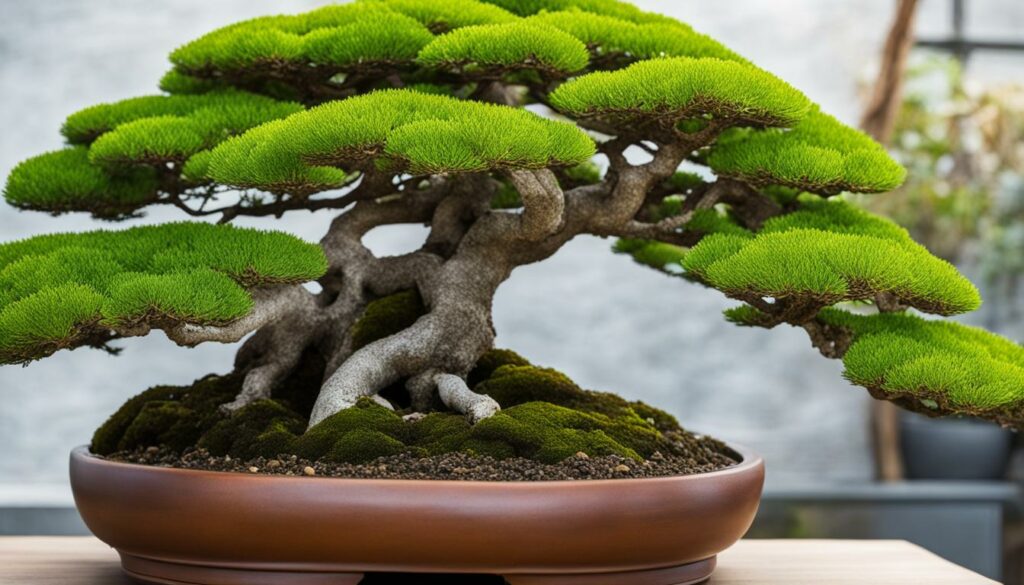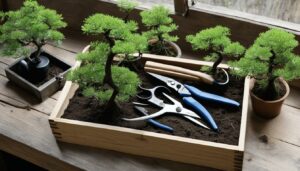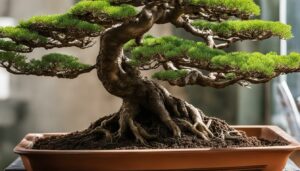Maintaining the splendor of your bonsai extends beyond meticulous pruning and shaping – it encompasses a vigilant approach to bonsai treatment, with a spotlight on disease prevention and insect control. These miniature masterpieces encapsulate beauty and serenity, yet their plant health is constantly under siege by an array of pests and diseases. Safeguarding these treasured plants is integral to preserving their visual poetry, thereby ensuring their longevity and vitality.
Key Takeaways
- Understanding the inherent vulnerabilities of your bonsai is key to protecting it from pests and diseases.
- Proactive bonsai treatment and disease prevention trump reactive measures every time.
- Recognizing early signs of infestation or illness can save your bonsai from severe damage.
- Insect control is a critical component of preserving plant health in bonsai care.
- Regular care and attention are paramount for ensuring the ongoing health and beauty of your bonsai.
Understanding the Vulnerability of Bonsai to Pests
The allure of bonsai trees lies in their miniature size and the precise care they require, but these very characteristics make them vulnerable to a variety of pests. Unlike their outdoor counterparts, bonsai trees live in more controlled yet constrained environments, often indoors, where pest management is a crucial element of plant health. The limited soil volume of bonsai pots is one factor that can lead to increased stress on the plant and thereby increase susceptibility to bonsai pests.
Unlike full-size trees that have expansive root systems and greater energy reserves, bonsai trees have restricted space and resources to rebound from pest attacks. This can lead to rapid health declines if infestations are not identified and addressed swiftly. In the face of such threats, the importance of early detection cannot be stressed enough—it is your first line of defense. Familiarity with signs of common pests such as discolored leaves, stunted growth, or visible insects is vital for the early intervention and subsequent bonsai treatment.
- Inspect new additions to your bonsai collection thoroughly to prevent the introduction of pests.
- Regularly check the underside of leaves, a common hideout for pests, as part of routine care.
- Isolate affected plants immediately to curb the spread to your other bonsai.
Creating a tailored routine for insect control is essential for maintaining the delicate balance required for bonsai health. This involves not only responsive measures but also preventive practices such as proper watering, fertilization, and ensuring adequate light—each element playing a role in fortifying the plant’s natural defenses against pests. By understanding and respecting the needs of your bonsai, you are more likely to enjoy a healthy and fulfilling bonsai gardening experience.
Common Bonsai Pests and Signs of Infestation
Ensuring the plant health of your bonsai is integral to its flourishing, which includes timely insect control and bonsai treatment. Knowledge is your best defense. Understanding what to look out for can prevent the bulk of issues that arise from common pests. Let’s delve into identifying and managing some of the more prevalent pests that may visit your bonsai.
Identifying Spider Mites and Their Effects on Bonsai
Spider mites pose a significant threat as they are tiny and often overlooked until they’ve caused considerable damage. These pests thrive in warm, dry environments, making indoor bonsai particularly susceptible. Look closely at your bonsai’s leaves for fine webs, speckling, or a bronze hue which indicate an infestation. These mites can cause defoliation and, in severe cases, death if left untreated.
Recognizing Scale Insects and Their Damage
Scale insects are another common foe of the bonsai. They appear as small, brownish lumps on leaves and stems that suck the sap from your tree, weakening it over time. Yellowing leaves or a sticky residue known as honeydew, which often leads to sooty mold, are telltale signs of these hard-to-remove pests.
Dealing with Aphids on Your Bonsai
Aphids are small, pear-shaped insects that can be found in clusters on new growth or the undersides of leaves. Their presence is often betrayed by distorted growth, yellowed leaves, or the secretion of honeydew. Vigilant inspection and prompt treatment are crucial in curtailing the damage they can wreak on plant health.
In summary, maintaining vigilance and embodying proactive bonsai treatment techniques are key in preserving your bonsai’s beauty and health. Regular inspection will help catch the signs early, and understanding the appropriate insect control methods will ensure that your treasured bonsai remains in peak condition.
Typical Bonsai Diseases and Their Symptoms
When nurturing bonsai trees, an understanding of common diseases and their early symptoms is critical for effective bonsai treatment and disease prevention. Keeping these miniature trees in prime condition requires not just meticulous care but also vigilance in monitoring plant health.
Root Rot: Causes and Early Detection
Root rot, often undetected until it’s severe, strikes when roots of bonsai trees are subjected to excessive moisture. This can stem from overwatering or poor drainage, creating an environment where fungi thrive. Indicators of this disease include a mildew-like odor, discolored leaves, and a receding or mushy soil line. Early recognition and prompt intervention can salvage a bonsai from further decline.
Recognizing Fungal Infections in Bonsai Trees
Fungal infections in bonsai trees can manifest as powdery mildew, leaf spot, or rust—each with distinctive symptoms. Powdery mildew leaves a white, dusty coating on leaves, while leaf spot is characterized by brown or black spots circled by yellow haloes. With rust, you’ll often find orange or brownish pustules on the undersides of leaves. If you notice such symptoms, it’s imperative to initiate bonsai treatment immediately.
Understanding the diseases that can affect your bonsai is a fundamental step towards ensuring your venerable miniature tree thrives for years to come. Early detection promotes more straightforward disease prevention and keeps your bonsai not just surviving, but thriving.
Preventive Measures for Bonsai Plant Health
Ensuring the health of your bonsai begins with proactive prevention. Critical to disease prevention and plant health are the measures you take to create an environment around your bonsai that promotes vitality and deters pests. A fundamental component to maintaining your bonsai’s well-being is regular and thorough monitoring for early detection of problems. Let’s examine some best practices for bonsai treatment that can help keep your beloved miniature trees in prime condition.
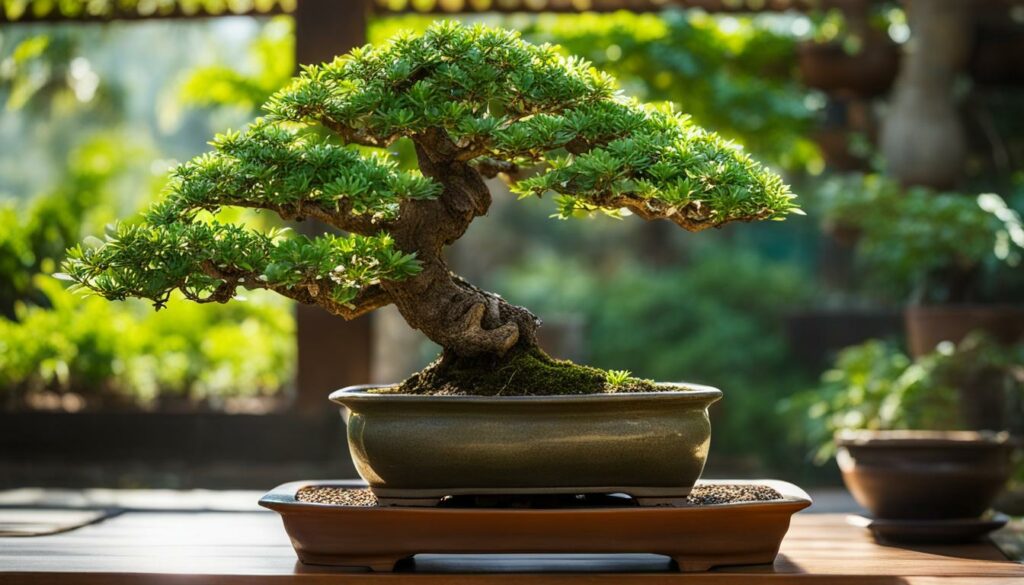
Monitoring and Care: Periodically inspect your bonsai for signs of distress, such as discolored leaves or a sticky residue on the foliage, which might indicate an issue. Such attentiveness to changes can be crucial to halting the advance of any disease or infestation.
- Examine new growth for abnormalities.
- Check the underside of leaves for pests.
- Be alert to any changes in leaf color or texture.
Cultural Practices: The right care practices underpin a preventative strategy against diseases and pests. Efficient watering, feeding, and pruning all play a critical role in maintaining plant health.
- Water only when the soil is slightly dry to the touch to avoid overwatering.
- Fertilize appropriately according to the species and the season.
- Prune strategically to improve air flow, which can reduce moisture-related problems.
Environmental Factors: Optimizing the environment in which your bonsai lives helps create a hostile setting for pests and diseases while nurturing the plant’s growth.
| Factor | Preventive Action |
|---|---|
| Light | Ensure the bonsai receives the right amount of light for its specific species. |
| Humidity | Maintain moderate humidity around your bonsai to prevent fungal growth. |
| Temperature | Keep your bonsai within its preferred temperature range to reduce stress. |
| Circulation | Allow for adequate air circulation to discourage pest invasion. |
By integrating these strategies into your routine care, you will be taking the necessary steps towards disease prevention and ensuring long-term plant health. Bonsai trees, like all living things, thrive with the right balance of attention and environmental conditions.
The Role of Proper Bonsai Soil in Disease Prevention
For any bonsai enthusiast, understanding the foundational role that soil plays in the health of your bonsai is critical. A suitable soil mix does more than just hold your plant in place; it’s the lifeline that provides nutrients, aeration, and proper drainage. Neglecting the quality of soil can lead to a host of problems, including disease, which can be detrimental to plant health and hinder effective bonsai treatment.
Choosing the Right Soil Mix
Selecting the ideal soil mix for your bonsai is a delicate balance that must consider the specific needs of your bonsai species. The right mix will facilitate root growth and health, contributing to the overall vigor of your plant. It becomes a preventative measure against common disorders, playing an essential part in disease prevention.
Benefits of Adequate Drainage
Ensuring your bonsai soil has proper drainage is non-negotiable. Saturated, poorly draining soil creates an environment ripe for pathogens, leading to root rot and other moisture-related conditions. By providing adequate drainage, you actively participate in preventing these issues, thereby promoting robust plant health.
| Soil Component | Function | Benefit to Bonsai |
|---|---|---|
| Akadama | Particle soil that provides excellent drainage and holds nutrients | Promotes root health and structure, essential for disease resistance |
| Pumice | Improves aeration and drainage, prevents soil compaction | Facilitates oxygen reach to roots, reducing risk of root diseases |
| Lava Rock | Adds structure, aids in drainage, and helps retain water | Ensures a stable root environment for improved plant resiliency |
| Organic Potting Mix | Supplies organic matter and nutrients | Feeds the bonsai while deterring disease through nutrient balance |
A carefully chosen soil composition, enhanced with these components, can significantly aid in disease prevention, providing your bonsai tree with a strong foundation for long-term plant health.
Remember, the time and effort you invest in selecting and maintaining the proper soil for your bonsai will pay off in the lush, green vibrancy of your miniature trees. Keep disease at bay through thoughtful bonsai treatment that begins beneath the surface, where healthy growth takes root.
Maintaining an Optimal Environment for Bonsai Health
Ensuring the health of your bonsai extends beyond meticulous pruning and feeding; it fundamentally involves creating an environment that promotes plant health and facilitates disease prevention. Achieving the right balance in the surroundings of your bonsai is instrumental in providing it with the conditions it needs to thrive and ward off potential afflictions. In this section, we’ll delve into two critical environmental factors: light requirements and air circulation.
Understanding Light Requirements
Bonsai trees require a certain quality and quantity of light for photosynthesis, growth, and development. While each species has its own specific needs, most bonsai will benefit from being placed in a spot where they can bask in bright, indirect light. Too little light can lead to weak foliage and a decline in plant health, while direct sunlight can scorch leaves and enhance the stress on the tree, making it more susceptible to pests and diseases. Adjusting your bonsai’s exposure to natural light is a delicate form of bonsai treatment, fostering robust growth.
The Importance of Air Circulation
Proper air circulation is pivotal in maintaining a healthy bonsai environment. Stagnant air can harbor pathogens and encourage the development of fungal diseases by allowing moisture to accumulate around your plant. Good air flow assists in drying excess moisture and provides fresh carbon dioxide, which is essential for your bonsai’s respiration process. By maintaining an area with adequate air movement, you significantly reduce the risk of pest infestations and promote the overall plant health of your bonsai.
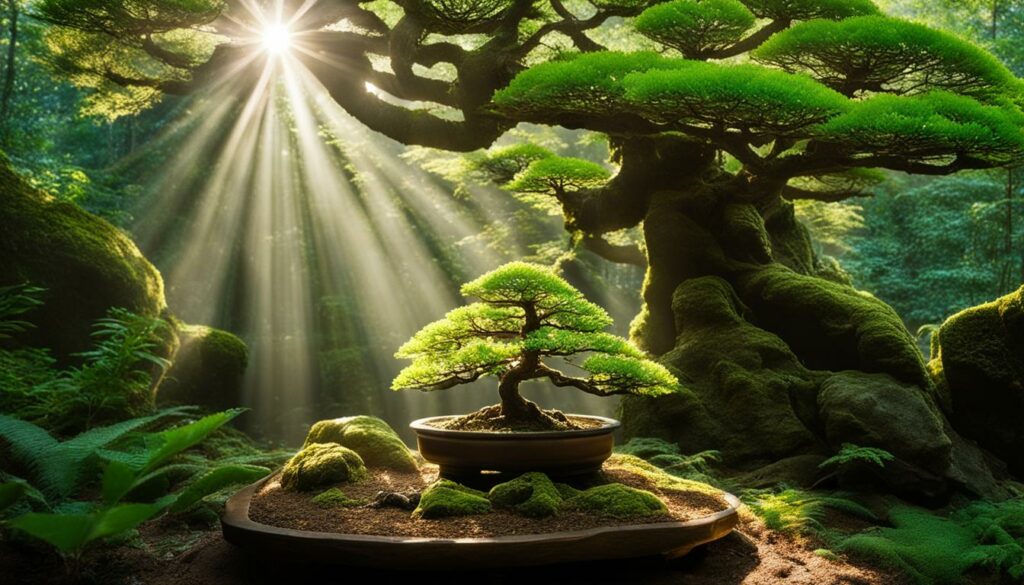
Natural Solutions for Insect Control on Bonsai
Embracing natural solutions for insect control is not only beneficial for the health of your bonsai but also for the environment. Many gardeners are turning to organic methods to treat and prevent common insect problems, avoiding potentially harmful chemicals. Below you’ll discover a range of effective, eco-friendly options you can employ to ensure your bonsai remains vibrant and pest-free.
- Neem Oil: A natural extract from the neem tree that acts as both a repellent and an insecticide, safe for use on bonsais.
- Insecticidal Soaps: Mild detergents that can effectively treat a variety of soft-bodied pests when applied directly.
- Beneficial Insects: Introducing insects like ladybugs or lacewings into your garden can naturally curb pest populations.
- Companion Planting: Certain plants can deter pests from your bonsai; for example, marigolds repel various insect pests through their scent.
These methods not only aid in insect control but also contribute to the overall plant health, forming a fundamental part of a holistic bonsai treatment strategy. Here’s a breakdown of these natural remedies and how they compare:
| Natural Remedy | Target Pests | Application Frequency | Notes |
|---|---|---|---|
| Neem Oil | Aphids, mites, scale insects | Every 2-3 weeks | Effective as both preventive and treatment measure |
| Insecticidal Soaps | Spider mites, whiteflies | As needed, when pests are visible | Gentle on plants, avoid use in direct sunlight |
| Beneficial Insects | General pest populations | Seasonally, as required | Supports ecological balance, ongoing insect control |
| Companion Planting | Varies based on companion plant | Plant at the start of the growing season | Long-term strategy, enhances biodiversity |
Maintaining the health of your bonsai is simpler and safer when adopting these natural insect control methods. Such bonsai treatments encourage growers to be more mindful of the environment while ensuring that the unique beauty of these miniature trees is preserved for generations to come.
Chemical Treatments: When and How to Use Them
While appreciating the beauty of your bonsai, effective insect control may call for the use of chemical treatments, particularly when you’re facing a severe pest challenge. It is crucial to understand when such measures are warranted and how to apply them without harming your precious plant. This guide will lead you through the essential steps to ensure your bonsai’s plant health is safeguarded during the treatment process.
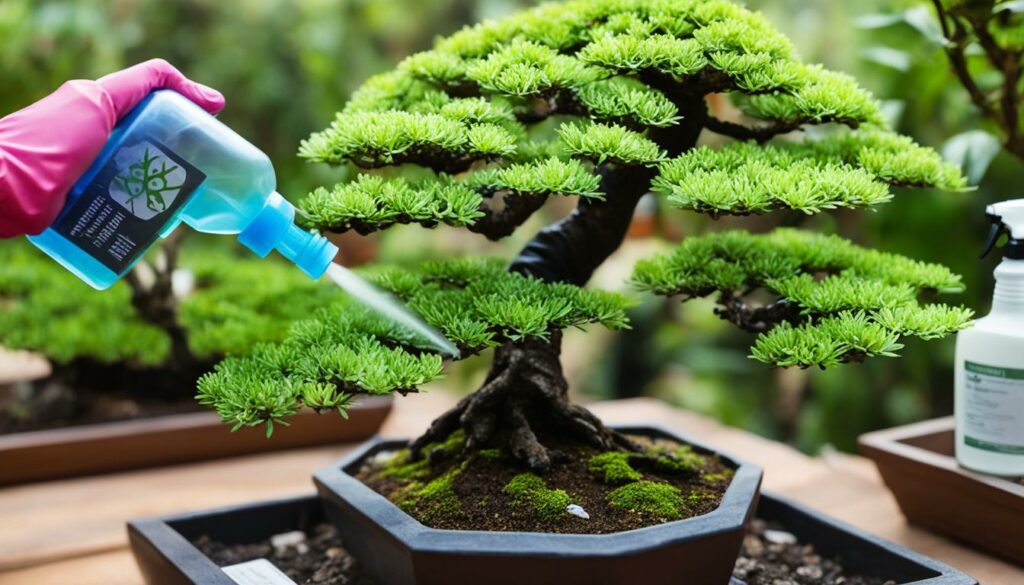
Selecting the Right Pesticides
The selection of pesticides is a critical decision that can have a profound impact on the bonsai treatment outcome. Factors such as the type of pest, the stage of its life cycle, and the particular species of bonsai must all be considered to make an informed choice. It is beneficial to use products that are specifically formulated for bonsai or similar delicate plants to minimize potential side effects.
Applying Chemicals Safely to Bonsai
Careful application of pesticides is as important as the selection process. Protective gear should be worn to prevent personal exposure to chemicals. When applying the pesticide, ensure that it is a calm day without wind, to avoid drift and uneven application. It’s preferable to treat your bonsai during the cooler parts of the day to lessen the stress on the plant.
| Pesticide Type | Target Pests | Application Notes |
|---|---|---|
| Insecticidal Soap | Aphids, Spider Mites | Apply directly to insects; avoid overuse. |
| Neem Oil | Scale Insects, Whiteflies | Effective as both a pesticide and a fungicide. |
| Systemic Insecticides | Various Insects | Infuses bonsai, protecting it over time; use sparingly. |
Remember to follow the manufacturer’s instructions carefully, and after treatment, monitor your bonsai closely to assess the effect on the pest population, as well as any signs of stress to the plant. Sometimes, a repeat application may be necessary, but always allow sufficient time between treatments to prevent overexposure. Your bonsai’s health is paramount, and a strategic, measured approach to chemical use will serve you well in maintaining its aesthetic and vitality.
Inspection Routines to Safeguard Your Bonsai
Regular inspections are a cornerstone of effective disease prevention and insect control in the care of your bonsai. As part of a comprehensive bonsai treatment plan, an inspection routine can help you catch issues before they escalate. Noting the condition of leaves, soil, and even the pot itself, could alert you to take necessary actions early.
To begin, establish a routine that includes a thorough check of your bonsai’s health at least once a week. Look for discoloration, spots on leaves, or signs of insects. Equip yourself with a magnifying glass to detect the early signs of pests or diseases that typically go unnoticed to the naked eye.
Remember, early detection is key to protecting your bonsai from long-term damage.
Here’s a simple checklist to follow during your routine inspections:
- Examine leaf color and texture for signs of distress.
- Check under leaves and along stems for any signs of insect activity.
- Observe the soil for proper moisture levels and signs of mold or fungus.
- Inspect the drainage holes at the bottom of the pot for blockages that could cause root rot.
If you spot any abnormalities, isolate your plant to prevent potential spread to others and begin appropriate treatment immediately. For most pests and diseases, there are both organic and chemical treatment options available.
By maintaining vigilance with regular inspections, you can enjoy the beauty and tranquility of a healthy bonsai for years to come.
Bonsai Pests and Diseases: Expert Tactics for Tough Issues
When you’re faced with a stubborn bonsai pest or disease, ordinary care might not cut it. It’s time to deploy expert tactics that go beyond the basics. Drawing on the know-how of bonsai aficionados, we delve into powerful strategies for revitalizing your treasured tree and bolstering its plant health. Whether dealing with an infestation or a systemic issue, our guide provides the insights necessary for effective bonsai treatment and disease prevention.
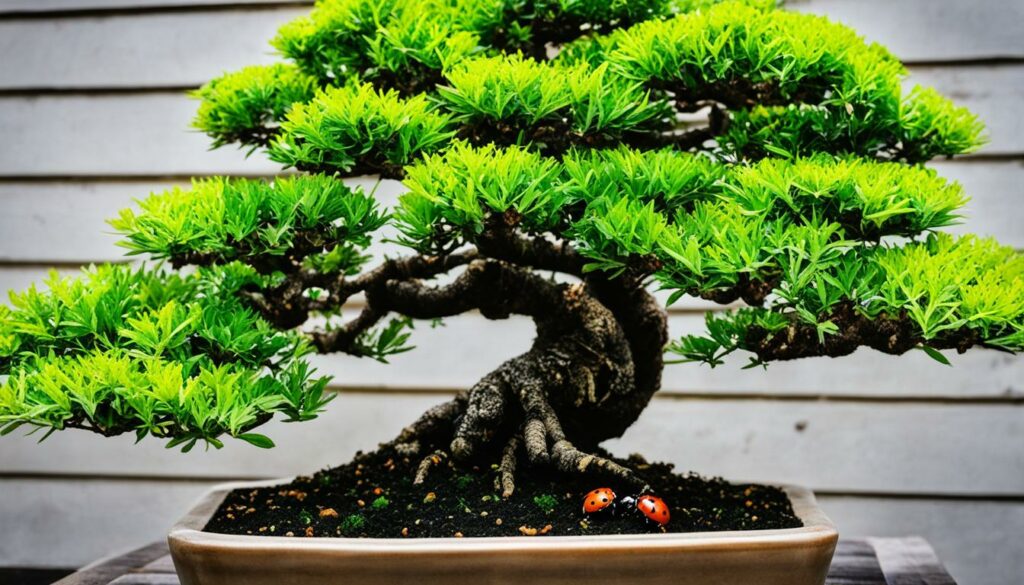
| Disease | Symptoms | Advanced Treatment Approach |
|---|---|---|
| Root Rot | Discolored leaves, stunted growth, foul-smelling soil | Trim affected roots, use fungicide, improve soil drainage |
| Fungal Infections | White, powdery mildew, or rust-colored spots on leaves | Prune infected areas, apply antifungal agents, adjust humidity levels |
| Bacterial Leaf Scorch | Brown, scorched leaf edges, leaf drop | Eliminate infected leaves, sterilize tools, increase air circulation |
“The effectiveness of treating bonsai diseases lies in early detection and immediate action. Diligence in monitoring plant health, coupled with the right expertise, can save your bonsai from severe damage.” – Bonsai Expert Council
Embrace an integrated approach to combat pests and diseases. Start with natural predators to control insect populations. If necessary, escalate to organic pesticides as a secondary measure, preserving the bonsai’s ecosystem. Remember, the resilience of your bonsai hinges on regular and informed care—consider these expert tactics a part of your comprehensive plan for a thriving bonsai.
When to Quarantine: Stopping the Spread of Issues
Encountering disease or pest infestations in your bonsai may require quarantining the affected plant to protect the overall health of your garden. Understanding the disease prevention tactics and bonsai treatment methods necessary to contain the issue will ensure your other plants’ plant health is not compromised.
Signs That Your Bonsai Needs to Be Quarantined
It is vital to recognize the warning signs that necessitate a quarantine. If you notice any of the following symptoms, it’s time to act:
- Unusual spotting or discoloration on foliage
- Evidence of insect infestation, such as webbing or visible bugs
- Sudden leaf drop or wilting that isn’t linked to under or over-watering
- Mold growth or fungus presence on the soil or plant
Effective Quarantine Practices
To enact an effective quarantine, adhere to these proven practices:
- Immediately isolate the affected bonsai in a separate room or space, away from other plants.
- Wear gloves when handling the quarantined bonsai to prevent cross-contamination.
- Monitor the isolated plant daily for changes or developments.
- Apply appropriate treatments for the specific pest or disease with caution to avoid affecting the bonsai’s recovery.
| Quarantine Step | Goal | Duration |
|---|---|---|
| Isolation | Prevent spread to other plants | Until visible signs of pests/disease are gone |
| Treatment Application | Eradicate pests/disease | As per treatment cycle (could be several weeks) |
| Monitoring | Ensure plant recovery | For a few weeks post-recovery |
Healing a Sick Bonsai: Recovery Techniques and Tips
When your bonsai displays signs of distress due to pests or diseases, a carefully considered treatment plan is essential for nurturing it back to health. Taking proactive measures for bonsai treatment, disease prevention, and maintaining overall plant health can lead to a successful recovery. Here’s how to help your bonsai overcome these challenges.
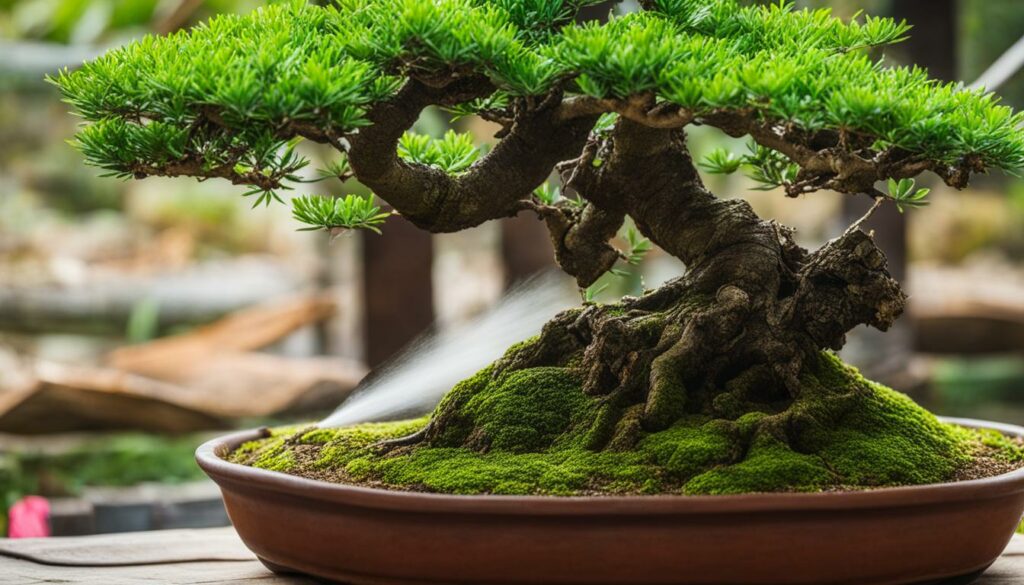
Reviving a Bonsai Suffering from Pests
The first step in reviving a bonsai that’s suffering from pests is to isolate the affected plant to contain the infestation. After isolation, you can begin treating your bonsai with insecticidal soap or neem oil, both known for their effectiveness in insect control. It’s important to apply these treatments according to the product instructions, usually during the cooler parts of the day, to prevent leaf burn.
- Inspect your bonsai thoroughly for signs of pests.
- Remove any visible pests by gently wiping the leaves and branches with a soft cloth.
- Apply a natural insecticide like neem oil, targeting all areas of the plant.
- Continue to monitor your bonsai daily and repeat treatment as necessary.
Remember, consistency is key to eliminating pests and ensuring your bonsai’s return to vitality.
Restoring a Bonsai Affected by Disease
Restoring a bonsai that’s been impacted by disease requires immediate action to halt further damage. Begin by pruning any diseased leaves, branches, or roots to prevent the spread of infection. Use clean, sterilized tools to avoid introducing new pathogens. If a fungal disease is present, applying a fungicide may be necessary.
- Prune diseased foliage and dispose of it properly.
- Improve air circulation around your bonsai by spacing plants or adjusting their location.
- Adjust watering habits to ensure proper drainage and avoid waterlogging, which can exacerbate disease.
- Apply a fungicide if recommended, following the product’s guidelines for application and safety.
After treatment, ongoing care includes regular inspections and adjusting environmental factors like humidity and light to promote recovery and deter future problems.
Your dedication to these recovery techniques and vigilant monitoring can help bring your cherished bonsai back to a thriving state, showcasing the resilience these miniature trees possess.
Expert Advice on Bonsai Treatment and Restoration
Embarking on the journey of bonsai treatment and restoration requires a nuanced approach, blending traditional practices with expert wisdom. To maintain exemplary plant health and ensure effective disease prevention, seasoned bonsai masters suggest several strategies honed by years of practice.
Bonsai aficionados often stress the importance of a tailored care regime for each unique tree. A one-size-fits-all method can neglect specific needs, threatening the plant’s delicate balance. Below, discover time-tested advice that speaks directly to the heart of bonsai cultivation:
- Observation: Vigilantly inspect your bonsai for any signs of distress. Early detection of abnormalities in leaf color, texture, or growth patterns could be indicative of underlying issues.
- Sanitation: Maintain cleanliness around your bonsai to avoid attracting pests or fostering disease. Overlooked fallen debris can be a haven for problems.
- Watering: Strict attention to watering practices is essential. Overwatering can lead to root rot, whereas under-watering can stress the plant, making it more susceptible to pests.
- Pruning: Regular and strategic pruning not only maintains the bonsai’s aesthetic form but also promotes healthy growth and aids in disease control.
- Feeding: Use the correct fertilizers to provide your bonsai with the nutrients it needs to thrive, reinforcing its defenses against pests and diseases.
When treatments are necessary, experts caution against hasty interventions. Proper diagnosis is crucial to apply the correct remedy, whether it involves adjusting care routines or implementing more active interventions. For instance, fungal issues require fungicides, but an incorrect diagnosis could lead to unnecessary chemical usage that might do more harm than good.
“The wisdom of bonsai is the patience it teaches, the observation it demands, and the calm it provides. Restoring a bonsai is akin to nurturing a friend back to health—a journey taken together, step by step.”
As you adhere to these expert recommendations, your bonsai is not just an object of beauty but a testament to the care invested in it—a living sculpture crafted by time and patience.
Protecting Your Bonsai from Future Pest and Disease Threats
Maintaining the health of your bonsai isn’t just a one-time action; it’s a continuous commitment to vigilance and care. By adopting regular habits for inspection and treatment, you can ensure your bonsai thrives, free from the threats of pests and diseases. Let’s explore some effective strategies that can set you up for long-term success in bonsai treatment and disease prevention.
Strategies for Ongoing Vigilance
Regularly examining your bonsai for any signs of distress is crucial for early detection of issues. Incorporate a weekly check-up into your routine, closely inspecting leaves, stems, and soil for unusual spotting, discoloration, or pests. Insect control methods such as washing leaves or applying neem oil can prevent small issues from becoming serious. A magnifying glass can be helpful for spotting mites and other tiny intruders.
Building Bonsai Resilience through Regular Care
Consistent care keeps your bonsai robust and better equipped to resist pests and diseases. This includes providing the right balance of light, water, and nutrients. Specific feeding schedules, coupled with the use of fertilizers tailored for bonsais, can promote vigorous plant health and strengthen natural defenses. Also, ensuring the bonsai’s environment has proper airflow can greatly reduce the threat of fungal diseases.
| Prevention Measure | Benefits | Frequency |
|---|---|---|
| Leaf inspection | Early detection of insects and signs of disease | Weekly |
| Soil examination | Prevents root rot and overwatering | Before each watering |
| Fertilization | Provides essential nutrients, enhances growth and health | As recommended for specific bonsai species |
| Pruning | Encourages air circulation, removes potential disease sites | When necessary, during growth periods |
By adhering to these practices, you can play a proactive role in preventing potential threats to your bonsai. Remember, a healthy plant is your goal, and proactive measures are your best tools for keeping your bonsai in top condition for years to come.
Conclusion
In the intricate dance of nurturing these exquisite miniatures of nature, your alertness to bonsai pests and diseases plays a leading role. We’ve traversed the landscape of disease prevention, delved into effective insect control, and embraced the practices that enhance plant health. It is through this cultivated knowledge and the artful execution of care that your bonsai can thrive, untarnished by the threats that loom in their delicate world.
Your bonsai relies on you to be its sentinel, vigilant against the earliest signs of ill health. With the insights and strategies provided, you now possess a green-thumbed wisdom to detect and deter the adversaries of your plant. Remember, the most robust defense is a strong offense—equipping yourself with these proactive measures will significantly mitigate the risks of infestations and illnesses.
You are the custodian of these living sculptures, and your dedication to their wellbeing ensures that these natural wonders endure. May you continue to find tranquility and joy in the serene presence of your bonsai, as you stand guard over its miniature canopy. With unwavering attention and responsiveness to your bonsai’s environment and needs, these living art forms will flourish, inspiring awe for years to come.
FAQ
How do I know if my bonsai is affected by pests?
Look for common signs such as discolored leaves, sticky residue on the plant or pot, visible insects, webbing, or a generally unhealthy appearance. Early detection is key to effective treatment of bonsai pests.
Are bonsai more susceptible to diseases than other plants?
Yes, due to their miniature size and often stressful growing conditions, bonsai trees can be more vulnerable to diseases. Providing the right care, such as proper watering and pruning, is crucial for disease prevention.
What are the most common pests that attack bonsai trees?
The most common bonsai pests include spider mites, scale insects, and aphids. Each pest has unique signs of infestation and requires different methods for successful insect control.
What should I do if I suspect my bonsai has root rot or a fungal infection?
If you suspect root rot or a fungal infection, look for symptoms like soft, brown roots or yellowing leaves. Isolate the affected plant and consult a bonsai expert or use recommended treatments specific for the issue.
How can I create an environment that’s less conducive to bonsai pest infestations and diseases?
Maintain a clean surrounding, ensure correct lighting and watering, provide adequate air circulation, and monitor for signs of stress. Healthy plants are less likely to succumb to pests and diseases.
How important is the right soil mix for preventing bonsai diseases?
Choosing the right soil mix is critical for ensuring proper drainage and aeration, which can prevent many common issues like root rot. The ideal mix varies depending on the bonsai species.
Can I use natural remedies to control insects on my bonsai?
Absolutely, natural methods such as neem oil, insecticidal soaps, and introducing beneficial insects can be effective in controlling pests without harsh chemicals.
How often should I inspect my bonsai for signs of pests or diseases?
Regular inspection, at least once a week, is recommended to catch any early signs of trouble. More frequent checks may be necessary during the active growing season or if your plant has had recent issues.
When is chemical treatment necessary for a bonsai tree?
Chemical treatment should be a last resort, used only when natural methods fail and the infestation or disease is severe. Always choose pesticides safe for bonsai and follow the application instructions closely.
How do I quarantine a sick bonsai tree?
Isolate the infected bonsai in a separate area away from other plants to prevent spreading. Ensure that it still receives the proper care and monitor its progress regularly. Clean and disinfect any tools used.
What recovery techniques can I use for a bonsai affected by pests or disease?
After treating the pest or disease, focus on restoring plant health with proper watering, feeding, and light conditions. Be patient and continue to monitor the bonsai for any further signs of decline.
Where can I find expert advice on bonsai treatment and restoration?
Consult reputable online forums, books written by bonsai experts, or local bonsai clubs. Experienced bonsai practitioners can offer valuable insights tailored to your particular situation.
How can I protect my bonsai from future pest and disease threats?
Maintain a routine care schedule, proper sanitation, and stay vigilant for any changes in your bonsai’s health. Keeping your bonsai strong and healthy is the best defense against future threats.
